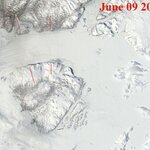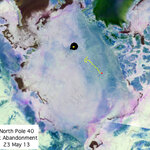Oceanography

Arctic summers could be ice-free as early as 2030, said Dr. Mark C. Serreze, director of the U.S. National Snow and Ice Data Center (NSIDC - part of the Cooperative Institute for Research in Environmental Sciences based at the University of Colorado in Boulder) in the briefing for a seminar to be held on Tuesday, July 16th, at 10 a.m. EDT.
In the session "Environmental Impacts of the Arctic's Shrinking Sea-Ice Cover" he will examine the social and economic effects of the retreat of the Arctic Ice Cap and the opening of the Arctic Ocean. Registration is open to everyone free of…

Over past centuries, the crews of ships regularly measured some basic properties of the waters through which they sailed, such as temperature and salinity.
Though their accuracy has to be questionable, these historical observations have proven to be important for climate modelers who are trying to validate their work. In recent years, the importance of the deep ocean as a sink for the extra energy trapped by anthropogenic climate change has come to the fore.
Unfortunately, the vast majority of deep ocean observations don't start until the 1980s. From 1925 to 1927, however, the…

From 1975 on, the global surface ocean had shown a pronounced, though wavering, warming trend. Starting in 2004, however, that warming seemed to stall. Researchers measuring the Earth's total energy budget - the balance of sunlight streaming in compared to the amount of light and heat leaving from the top of the atmosphere - saw that the planet was still holding on to more heat than it was letting out.
But with that energy not going into warming the surface ocean, a traditionally important energy sink, scientists weren't sure where it went. It became known as a case of "missing heat."…

Petermann Glacier 2013
If the feature arrowed in the image below is not a processing artifact, then Petermann Glacier is setting itself up for yet another major calving event. Further data is needed to support my suggestion that this is either a real fissure or the beginnings of one.
Petermann Glacier June 19 2013Unmodified part of of 250m scale satellite image,source:http://rapidfire.sci.gsfc.nasa.gov/imagery/subsets/?subset=Arctic_r03c03.2013170.aqua.250m
Below is an enhanced image showing that there are possibly two fissures. I repeat that this new feature needs to be confirmed…

Around The Arctic June 2013
The Arctic is currently primed for rapid and extensive ice loss, unless we see some very unusual weather conditions this Summer.
The state of the ice can be seen in the following series of satellite images from NASA's Earth Observing System Data and Information System - EOSDIS. EOSDIS produces near real-time data and makes images such as the Arctic mosaic and the Near Real Time (Orbit Swath) Images available on the web.
The Arctic mosaic is made up of panels arranged as six rows and six columns. Any panel can be viewed in higher resolution by clicking…

Glacier Changes in NE Greenland
Substantial cracks in the Nioghalvfjerdsfjorden glacier ice tongue appear to be growing in extent and number. While not as spectacular as the 2010 calving of the Peterman Ice Island, it is more closely linked to global warming than
Otherwise known as 79 North, Nioghalvfjerdsfjorden glacier is a floating outlet glacier, about 60 km long and 20 km wide located at 79°30'N, 22° W, draining a large area of the northeast Greenland ice sheet.
Recently observed cracks in the Nioghalvfjerdsfjorden floating glacier tongue.
Global warming was predicted to be most…

Jellyfish Blooms
Newspapers are currently reporting a surge in jellyfish numbers in the Mediterranean.
Along with the surge in jellyfish numbers, or bloom, is a surge in bad reporting about global warming. This is one occasion when I am on the side of the 'natural cycles' folks: jellyfish have a 20 year boom and bust natural cycle.
For the record: I am convinced that global warming is a reality and that we humans are causing it. There are many strange events which appear very likely to be caused by our profligate use of fossil fuels, but I do not count surges in jellyfish…

Reductions in Arctic sea ice levels may nfluence patterns of atmospheric circulation both within and beyond the Arctic, according to a simulation using 2007 ice conditions, the second lowest Arctic sea ice extent in the satellite era.
Two 30-year simulations, one using the sea ice levels of 2007 and another using sea ice levels at the end of the 20th century, were used to access the impact of ice free seas. The results showed a significant response to the anomalous open water of 2007.
The results project that the atmospheric response to declining sea ice could have implications…

Before the Oligocene epoch some 33.6 million years ago, the Earth was a warm place with a tropical climate. In this region, plankton diversity was high until glaciation - the Antarctic continental ice cap - reduced the populations leaving only those capable of surviving in the new climate.
Since that time, we have had seasonal primary productivity of plankton communities. This ice-cap is associated with the ice-pack, the frozen part that disappears and reappears as a function of seasonal climate changes. This phenomenon, still active today, influences global food webs, according to a paper in…

Arctic Ice 2013
This year looks set to be yet another year of extreme melting of Arctic sea ice. The majority of ice is first year ice. Previously-normal conditions ensured that young ice would enter the Beaufort Gyre and be trapped there for some years, growing in strength and thickness. This tended to compensate for the greater or lesser annual loss of older ice through Fram Strait. The loss through Fram Strait was formerly reduced somewhat by the obstructive effects of the Odden ice bridge. As I have noted before, the Odden has not formed since 1997 - a fact which…